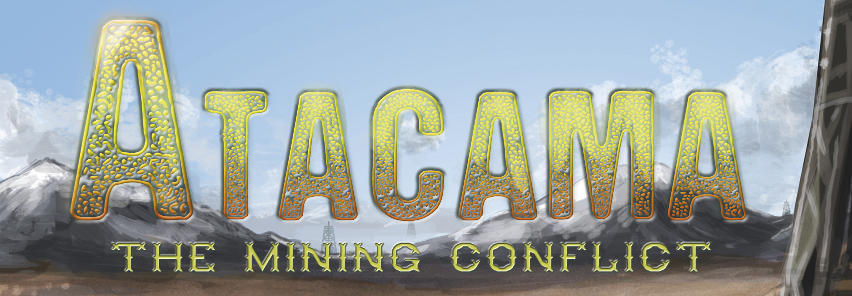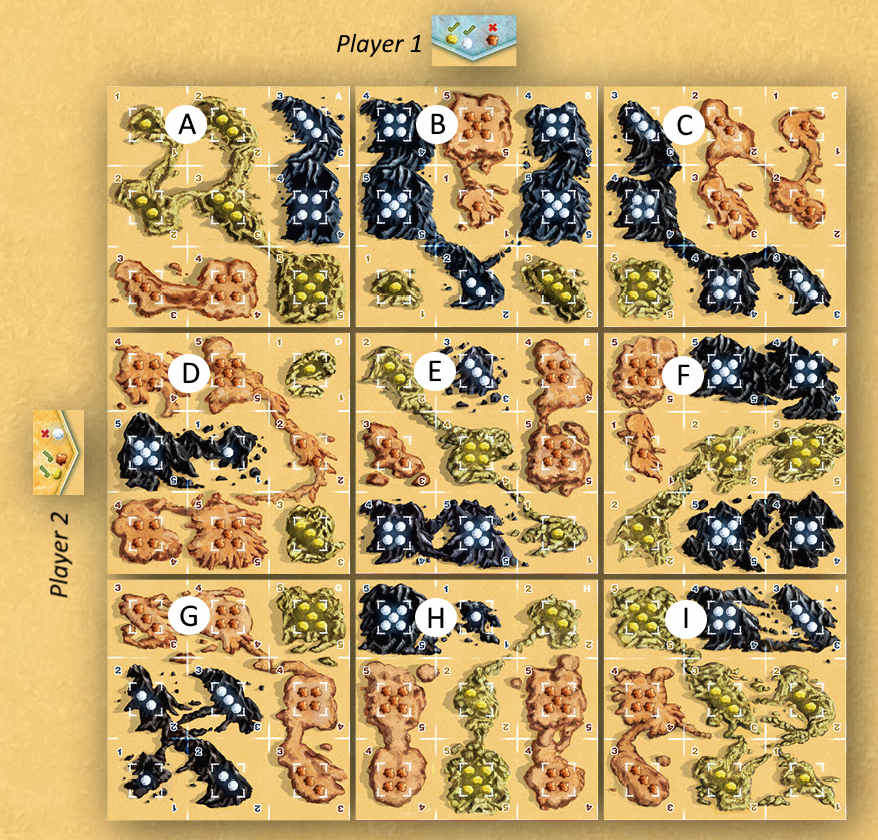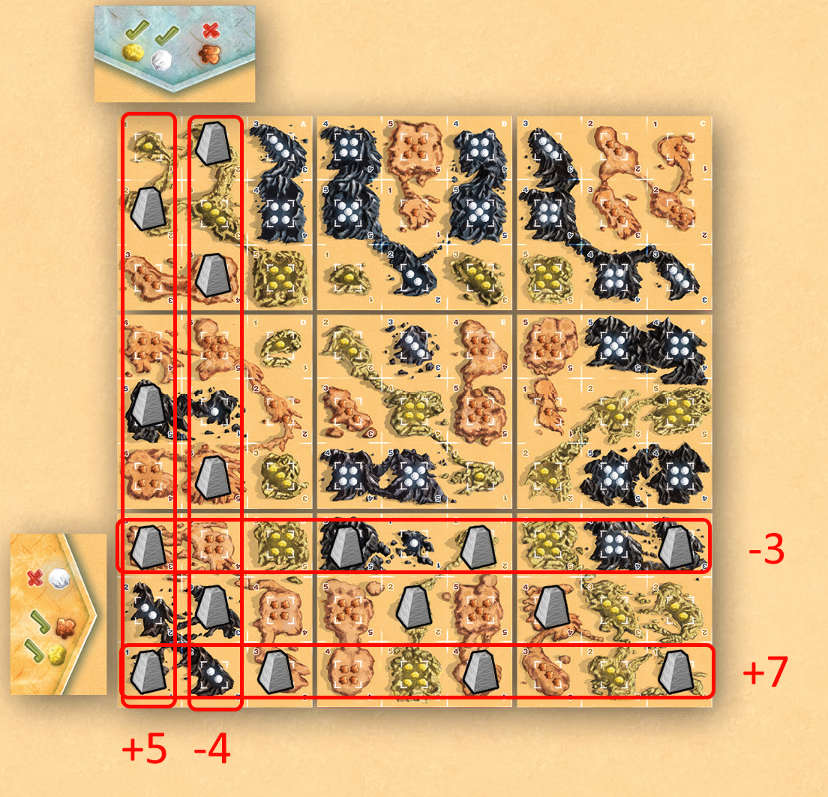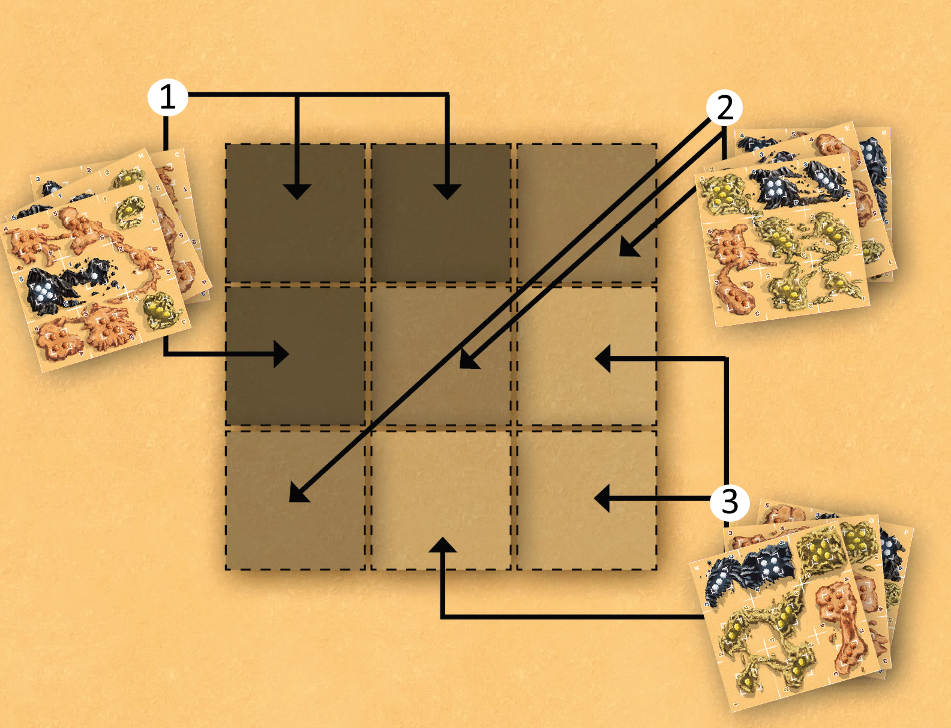
A game from Martin Schlegel for 2 or 4 players
Excitement in the Chilean desert.
Valuable mineral resources have been found in this 1,200 km long desert along the Pacific Ocean coast: Gold, silver and copper.
Several companies are already busy prospecting by erecting huge drilling rigs
since the seams are deep under the surface.
Due to security reasons the drilling rigs cannot be installed too close to each other,
which is why each new rig limits the possibilities to erect new ones in the surrounding.
Moreover, the mining rights have been limited by the government. Only for two of the three commodities the companies received a concession.
Extracting the "wrong" type of resource will result in penalties.
Getting rich is a tough business, but putting in effort can make it worthwhile.
Basic Game
Preparations
The 9 tiles are laid out to form a big square game board. The tiles with the letters A to C are
placed in the uppermost row, thereunder D to F followed by G to I. The tiles have to be placed with the letters
being in the top right corner.
Each player receives a mining concession. Player 1 receives the turquoise concession (no copper),
player 2 the orange concession (no silver).
The concessions are placed beside the game board (see illustration).
Each player receives 14 rigs of the basic color, which they place in front of them. The rigs in the other colour
are not used in the basic version.

Course of Action
Alternately, the players place one rig on the board. The following rules have to be paid attention to:
-
Only one rig may be placed on a field. Rigs may not be placed adjacent to existing rigs.
-
Adjacent means fields with common edges, diagonal adjacency is permitted.
End of the Game
When every player has placed their 14 rigs, the game ends. Now the winning points are calculated.
Only rows / columns with at least 4 rigs are assessed. And only the fields with rigs on are reviewed.
The mining concession shows for which commodities the players receive positive points,
but also, for which they do not have the concession, thus bringing negative points.
For the player with the mining concession above the game board the vertical columns do count.
For that player, occupied gold and silver fields count positively, occupied copper fields on the other hand negatively.
Each golden ore and every silver ore brings 1 positive point for the player, every copper ore is to be evaluated with 1 minus point.
For the other player, the horizontal rows are evaluated. For them, occupied gold and copper fields count positively,
occupied silver fields negatively. Each copper ore and every golden ore counts 1 positive point,
every silver ore is to be evaluated with 1 minus point.
The player with the most points is winner.
Basic Game Example
Preliminary Result after 16 placed Rigs
The first player (columns) momentarily receives 5 points in the first column to the left:
+2 points for gold, +5 for silver, -3 for copper and +1 for silver.
In the second column, they receive 4 minus points: +2 points for gold, -4 for copper, -5 for copper and +3 for silver.
The remaining columns do not count, since at the moment there are fewer than 4 rigs placed.
The second player (horizontal rows) momentarily receives 7 points in the lowermost row:
-1 point for silver, +3 for copper, +4 for copper and +1 for gold.
In the second lowermost row there are only 3 rigs, so this row does not count.
In the following row, they receive 3 minus points: +3 points for copper, -5 for silver, +2 for gold and -3 for silver.
The remaining rows again do not count, since there are fewer than 4 rigs placed (at the moment).

Enhanced Game
Preparations + Course of Action
Unlike the basic game, at the beginning it remains uncertain which player scores in the
horizontal rows and in the vertical columns.
The mining concessions have not yet been issued. The 9 tiles are shuffled and placed on the table face down.
-
With the top 3 tiles a triangle is laid, where the letters (whatever letter it is) must be in the top right corner.
Now every player alternately places 3 rigs according to the basic rules.
-
Then the next 3 tiles are placed diagonally. Again, the players alternately place 3 rigs.
-
Finally the 3 remaining tiles are placed. Thereafter, the players alternately place the remaining rigs.

In any move, a player can acquire one of the concessions. They then place it beside the game board in the direction (row/column) they choose.
They pay for the concession with one not yet placed rig, thus only playing with 13 rigs. When claiming the concession, they cannot place a rig on the board.
The other player receives the remaining concession. They have one more rig at their provision.
All other rules of the basic game apply.
Tactical Variant
Preparations + Course of Action
The rules for the two game variants can be intensified by using the rigs in the second colour as follows:
At the beginning, each player receives 11 rigs of the main colour and 3 rigs in the other colour.
The remaining 6 rigs are not used.
End of the Game
When calculating the points, rigs in the basic colour count according to the basic rule.
For the rigs in the second colour, the players receive double the value (plus and minus).
4-player Variant
Preparations + Course of Action
Unlike the above rules, now 2 players act in the horizontal rows and
2 players in the vertical columns.
The backsides of the concessions are required.
These show that one of the vertically acting players has the turquoise concession (no copper) and
the other the orange concession (no silver).
Likewise is true for the horizontally acting players: For one player the turquoise concession (no copper) is valid,
for the other the orange concession (no silver).
Each player receives 7 rigs in the main colour. The other rules remain as in the basic version.
Tactical Variant
The 4-player-variant also can be played in the tactical variant.
Each player receives 6 rigs in the basic colour and 1 in the other colour.